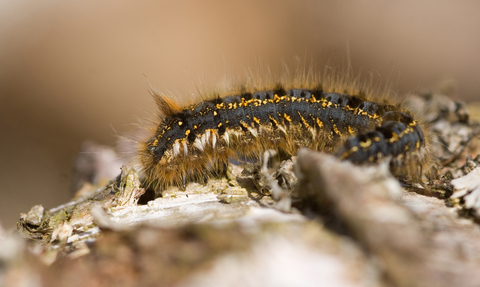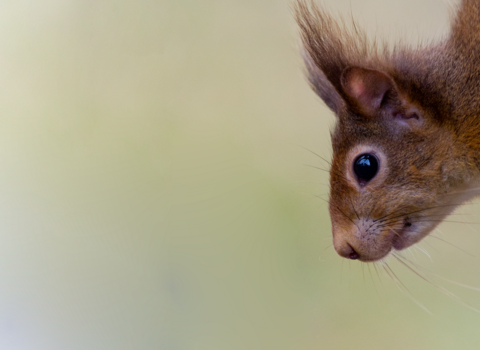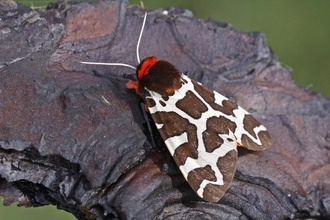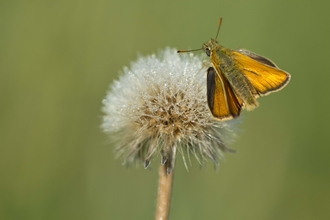
Drinker moth caterpillar ©Tom Marshall
How to identify caterpillars
What is a caterpillar?
A caterpillar is the larval stage of a moth or butterfly. It is the second part of their four-stage life cycle: egg, larva, pupa and adult. Many caterpillars look very different as they grow, so we've described the larger stages of the caterpillar's growth when they're often more obvious. Some are easily spotted on their favourite food plants. Here are some of the species you're likely to see!
Drinker moth
When & where: August-June. A variety of habitats including gardens, but especially damp grassland, marshes and boggy areas.
Description: Up to 7 cm long. Dark and covered with brown hairs and golden speckles. A row of white hairs runs down each side of the body.
Fox moth
When & where: June-April, most obvious in spring. Often heathland and coastal grassland.
Description: Up to 7 cm long. Hairy, with long dark hairs on the sides of the body and shorter orange hairs on top. Young caterpillars are dark with orange bands.
Oak eggar
When & where: August-June. A variety of habitats including grassland, heathland, fens, and hedgerows. Often found crawling across paths in spring.
Description: Young caterpillars in late summer and autumn are small and bluish with orange diamond patterns. More obvious in spring, when caterpillars are large and extremely furry, with long, orange-brown hairs. There are black bands between each body segment, and white dashes on each side.
Garden tiger
When & where: August-June. A wide range of habitats including gardens.
Description: Up to 6 cm long. An extremely hairy caterpillar, known as the "woolly bear". Mostly black and ginger, with longer white hairs.
Cinnabar
When & where: July-September. Found on ragwort in most grassy habitats.
Description: The caterpillars of this moth are distinctive, with black and yellow stripes - warning predators that they taste terrible. They're easily spotted feeding on ragwort.
Elephant hawk-moth
When & where: June-September. A variety of habitats, including gardens. Often where rosebay willowherb is found.
Description: Up to 8.5 cm long. A chunky green or brown caterpillar, with several eyespots at the front end and a spiky 'tail' at the rear.
Privet hawk-moth
When & where: July to September. Widespread in southern England and Wales. Found in a variety of habitats, including gardens.
Description: Up to 8.5cm long. Green and chunky, with purple and white stripes on the body and a black and yellow horn on the rear.
Puss moth
When & where: June to September. Widespread in a variety of habitats, including parks, gardens and wetlands. They feed on poplars and willows.
Description: Recently hatched caterpillars are tiny and black, with two long, whip-like tails. Older caterpillars are plump and green, with a dark, white-edged 'saddle'. The head is surrounded by a pink patch, with false eyes making it look like a giant face. They still have two thin tails. When they're fully fed and ready to pupate, they turn a purplish colour.
Mullein
When & where: April-July. A range of open habitats, including gardens. Feeds on mulleins and buddleia.
Description: Distinctive whitish caterpillars, with yellow splodges across the body and large black spots.
Yellow-tail
When & where: August-June. Scrubby habitats including hedgerows, woodland and gardens.
Description: Black with long, greyish-white hairs. On top it has a pair of red lines, with a row of white blotches either side of them. A red line runs along each side. The hairs can be an irritant.
Brown-tail
When & where: August-May. Scrubby habitats, including coastal scrub.
Description: Black with long brown hairs, two red spots on top and a line of white marks along each side. Found in conspicuous communal webs on food plants. The hairs cause skin irritation.
Knot grass
When & where: June-October. Grasslands, wetlands, heathlands, open woodlands, and coastal habitats.
Description: Black with brown hairs. Row of alternating red spots and lines on top, with a line of white dashes either side. Row of spots and dashes on each side. Rests with slight hunch in the back.
Peacock
When & where: May-July. Common in a range of habitats where common nettle is present.
Description: Up to 4.5 cm. Black with black spines and small white dots. Found in communal webs on common nettles.
Vapourer
When & where: May-September. Commonly found in a variety of habitats including woodland, parks and gardens.
Description: A funky-looking grey and black caterpillar, with large tufts of hair, including a mohawk of yellow tufts on the back. Large caterpillars can often be spotted in late summer on a range of shrubs and trees.
Pale tussock
When & where: June-October. Found on a wide variety of deciduous trees and other plants, including bramble.
Description: A striking bright green caterpillar, with black bands between its body segments, yellow/whitish hairs, a row of yellow tufts on top and a red tuft at the rear.
Not a caterpillar!
Sawfly larvae
Sawfly larvae look very similar to moth and butterfly caterpillars. However, sawflies actually belong to a group called hymenoptera. This order of insects also includes ants, bees and wasps. Sawfly larvae are usually 1-4 cm long, but come in an impressive variety of colours. One way to spot one is to count the legs - they also have six true legs, but usually have six or more pairs of the stumpy 'prolegs', whereas caterpillars have five or fewer.



















































